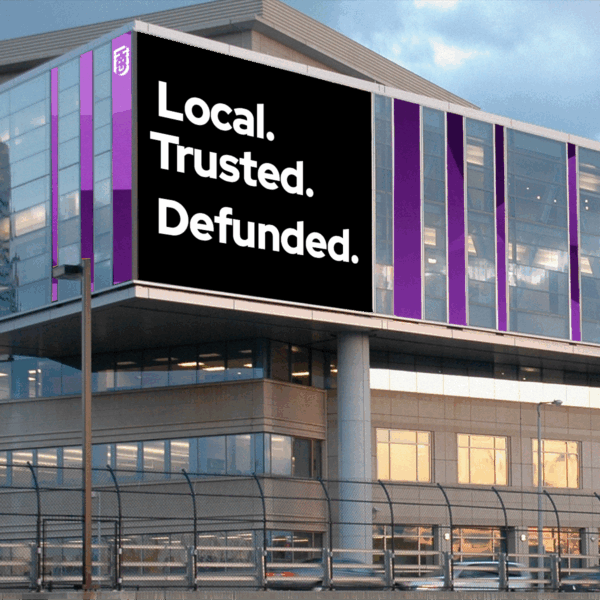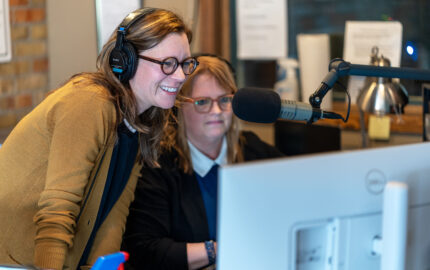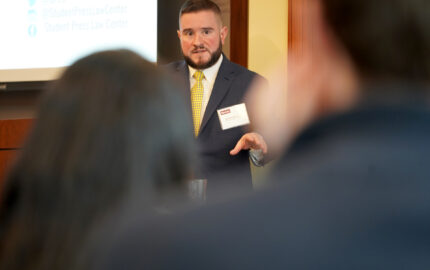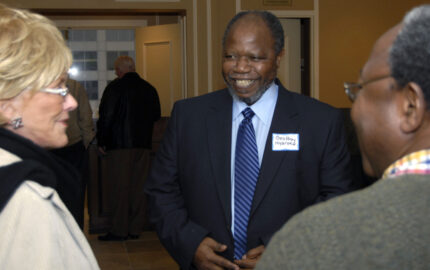When the U.S. Congress voted this summer to rescind $1.1 billion previously allocated for public broadcasting, it was the largest victory yet in the nearly 60-year fight conservatives have waged on government-supported media.
Opponents of public broadcasting say they’re fighting against government funding for left-wing media (bias charges that don’t tend to hold up to critical review). But due to the unique structure of public broadcasting in the U.S., Congress couldn’t cut money to National Public Radio (NPR) or the Public Broadcasting Service (PBS) directly. Instead, it pulled funding to the Corporation for Public Broadcasting (CPB), which was set to distribute most of it to about 1,500 radio and TV stations across the country that pay NPR and PBS to air their programs.
The Rescissions Act marked the end of the CPB, which announced Aug. 1 that it would lay off the majority of its staff by the end of September and wind down all operations by the end of January. Calling public media “one of the most trusted institutions in American life,” CPB President and CEO Patricia Harrison said in a statement that, despite the millions of Americans who called, wrote, and petitioned Congress to preserve the federal funding, “we now face the difficult reality of closing our operations.”
The closure of the CPB will hurt NPR and PBS, but the most immediate and devastating blow will be to the communities that rely on public broadcasting. Some may lose access to educational children’s programming. Others could lose city hall coverage, music programs, or the only source of information during emergencies. The precise effects are difficult to predict, since the role public media plays varies station by station, community by community.
“It's hard to view it as a very careful, tailored, sculpted decision to disapprove of particular uses of the money in public media,” said Martha Minow, a professor at Harvard Law School and chair of the board of trustees at the nonprofit Boston public media producer GBH. “There are voices that are opposed to public media, but … they tend to be think tanks. It's not ordinary people, it's not voters who are opposed."
That’s what makes the recent conservative-led victory even more striking: President Donald Trump’s Republican Party seems to be in near lockstep in its opposition to public media funding. Sens. Susan Collins of Maine and Lisa Murkowski of Alaska — two states with heavily rural or remote populations — were the only Republicans to vote against rescissions in their chamber.
In its wide scope and blunt strategy, the rescissions are like other actions of the Trump administration. At the White House’s request, the money for public broadcasting was “clawed back“ — to use a congressional colloquialism — along with nearly $8 billion allocated for foreign aid, on the heels of the “One Big Beautiful Bill Act,” which included cuts to health care and food assistance programs. This followed months of abrupt and drastic cuts by the Department of Government Efficiency, which swept across numerous agencies, including those that cover education, housing, labor, Social Security, and environmental protection, among many others. Higher education, health, and science have also been targets of funding restrictions and executive actions.
“I think that we're looking at, logically, something that is holistically based in the vision of how they treat all services,” said Josh Shepperd, an associate professor at the University of Colorado and the director of the Library of Congress Radio Preservation Task Force who has written about the history of public radio. ”Public media seems almost like a footnote. However, it is this crucial, aspirational, democratic experiment.”
That experiment isn’t over; it’s entering a new and unknown phase. Shepperd and others say some form of public media will surely survive. Parts of it may even thrive and grow. But the world that public media exists in — and the way many people see that world — has been fundamentally changed.
The stations that are the most at risk tend to be rural. As of the 2023 fiscal year, the CPB reported that about a third of its appropriation went to rural stations. Native Public Media President and CEO Loris Taylor, in a statement issued during the funding debate, called the CPB’s support for stations that broadcast to Indigenous communities "irreplaceable.” In particular, Taylor highlighted the news, culture, and emergency alerts provided by Tribal radio. “These are not luxuries. They are part of the public safety infrastructure that saves lives,” Taylor wrote.
An analysis of station finances on Semipublic, a newsletter run by former public radio employee Alex Curley, surmises that some 15% of local stations are at the risk of closing within three years as a result of the cuts. Curley set up a site called Adopt a Station that encourages donors to support stations that are losing 50% or more of their funding, such as those in Pendleton, Oregon; Harlem, Montana; and Dunmore, West Virginia. In some places, public media is the last, or nearly the last, local media outlet left, as consolidation, corporate cost cutting, and the loss of ad revenue have led to the closure of newspapers.
The existence of stations in sparsely populated or hard-to-reach areas is closely tied to the origins of public broadcasting in the U.S. The Public Broadcasting Act establishing the CPB passed in 1967 in the flurry of Great Society legislation — initiatives led by President Lyndon B. Johnson with the goal of combating poverty and racial injustice. The idea of noncommercial, public-service broadcasting is rooted in the belief that the government should play a role in educating its citizens, even those in far-flung rural areas. Early broadcasters provided continuing education programs. These stations were often based at universities — and land-grant universities at that: state schools aimed at democratizing access to education through offerings like agricultural studies.
“It's a completely different vision for what the technology is supposed to serve,” Shepperd said. Things like children’s programming, documentary films, and feature stories from small communities gradually came to fit into this educational mission as public broadcasting took shape on both television and radio.
The idea that the government would support the distribution of news — even news that might be critical of the government — wasn’t unique to radio or television. “A lot of people think the First Amendment means government stays out of anything to do with news or speech, and that's never been the case,” Minow said. “The very first postal act created a subsidy for the distribution of newspapers.” The government also invested in telegraph lines and the development of the internet, Minow added.
Lots of countries have public media, but the American system of a government-chartered corporation awarding grants to independent stations — which also accept donations and sponsorships, and which contribute to national networks but aren’t owned by those networks — is “extremely novel,” according to Shepperd.
It’s also extremely confusing. Follow closely on your local station and you’ll hear myriad acronyms for networks, funders, and distributors. I started my career at WFPL (it began as a service of the Free Public Library) in Louisville, Kentucky. We received money from the CPB and ran shows by NPR, PRX (Public Radio Exchange), and APM (American Public Media). Some stations and the shows they air get almost no government support, and survive on outside sources of funding (WFPL got about 6% of its budget from the CPB). Others, though, get more than half their budget from the CPB. It varies by station. And this is something else the jumbled alphabet of programs can distract from: Decisions on spending, programming, music, and news coverage are made at the station level, with a local staff, operating for a local audience.
Government support, especially for small stations, preserves this independence in the face of market forces that have otherwise largely abandoned local news and information. Public media stations are also some of the last broadcasters of classical music or of local music (which is also under threat, since the CPB paid for the rights for stations to air music, and licenses will expire in January). They may provide the only local voice on air in the morning giving the weather report.
“Commercial stations will not pick those back up — they're not profitable,” said Ele Ellis, CEO and general manager of Blue Ridge Public Radio (BPR) in North Carolina. In 2024 (before Ellis’ tenure — she joined in April), BPR was one of the only local outlets providing information on-air and online in real time during deadly flooding in and around Asheville. There are similar stories from other markets, in other weather disasters, when access to hyperlocal coverage, such as which evacuation routes are open, can be lifesaving.
Most people hear about stories like the deadly Asheville flooding — or any major disaster or emergency — only after national news outlets arrive on site. That’s often long after local broadcasters have been providing essential information to residents. The difference in the coverage timeline is crucial. “‘NBC Nightly News’ can show you pictures of devastating flooding,” Ellis said, but they don’t tell locals where to get fresh water. “NBC News is not for that.”
Opponents of public media say there’s no need for government funding of radio signals, since the internet exists. But online news is suffering from the same market forces that are devastating the wider media industry. The decline in readership due to artificial intelligence summaries on search websites, for example, has led to what’s now dubbed a “traffic apocalypse,” leading readers away from original news sites. Billionaire owners of news outlets have stripped much of the rigor and value from their investments. And what remains of online news is largely nationally focused.
”The local community is simply not going to be given attention in national and international news,” said Minow, who is also the author of “Saving the News,” a book about the new media landscape. “The economics of the industry are such that you don't have interest in local stories, you don't have the advertising that supports it, and meantime, those technological developments of digital media and the internet and AI have so disrupted the business models for local news that they find it very, very difficult to sustain.”
Some see the Rescissions Act as a potential wake-up call. Public media had problems before the funding cuts. Coverage didn’t always match the needs of a community or represent its diversity. As FM listening declined, many radio stations were struggling to stay solvent and relevant, and to find digital audiences and revenue while holding on to their dwindling but supportive broadcast audience.
“Stations that have been allowed to coast along, knowing it's going to be a problem, but still not able to deal with the problem yet, are going to have to deal with it,” Ellis said. “But I will say it's scary, because a lot of those stations … put serious time and energy and probably a lot of money into digital, hoping that it would pan out. And it hasn't panned out how they hoped it would.”
“The end of CPB funding is painful, but it is not paralyzing,” Loris Taylor of Native Public Media wrote in a statement after the CPB announced its closure. “It may push the public media sector to reimagine itself not as a government-funded service, but as a dynamic, community-owned ecosystem.”
Some of this work has fallen to journalists outside of public media. After my former employer WAMU, a station based at American University in Washington, D.C., abandoned the DCist website, a group of former employees launched a digital news startup called The 51st, one of a number of new nonprofit sites aiming to fill gaps in local news coverage.
“Indeed, the emergence of local digital nonprofits is, in many cases, also the story of public radio stations having missed a critical opportunity,” Richard J. Tofel, the founding general manager of ProPublica with a long career in journalism wrote in a newsletter shortly after the rescissions measure passed.
Public media stations have seen a surge in donations since the measure was introduced. WFPL and its sister stations easily made up a gap of just under $400,000 in a single day. BPR stands to lose about $300,000. Ellis is confident listener contributions will make up the difference.
In the success of startup sites, and in the fundraising boost to some stations, there are signs that audiences are willing to support local news, in contrast to the type of big-money market forces that created news deserts in the first place. Minow points out that tax exemptions for charitable contributions to nonprofits — including news outlets — are another type of government subsidy for news. But whether this surge of support will last, and whether it will be enough to support outlets across the country, is still an open question.
“Is it sustainable all over the system? Absolutely not. Will some of those little stations close down? For sure. Because they're fundraising as hard as they can already with the few people they have on their staff,” Ellis said.
If stations with larger local donor bases and the resources to court foundations can shore up their budgets, then Shepperd predicts the public radio system will have “stronger centers” based in those markets.
“Maybe 20% of the country is effectively going to lose any concept of itself as a place within the next 10 years without public media. They're essentially all going to have national ideology on the local level, and no local memory and no local experience."
— Josh Shepperd, associate professor at the University of Colorado, undergraduate chair of the Department of Media Studies
On the fringes, as smaller stations close, their communities may be left without local media. Those that survive will have less to broadcast, because they have smaller staffs, smaller budgets to acquire programming, and fewer options of what to acquire. Minow said GBH, which produces nationally broadcast shows like the science show “Nova” and the investigative journalism show “Frontline,” have had to make cuts quickly, since the rescissions measure canceled funds that had already been allocated.
“I'm confident that we will have media and we will have public media,” Minow said.
“But I'm also sure that the communities that will suffer the most are those that already have the fewest resources.”
The stakes of losing support for local media are more than the loss of news. “Communities that don't have local news or that lose their local news coverage have increases in corruption, both in the government and in the private sector,” Minow said. “Those that don't have local news or that lose their news coverage have decreases in voting and other forms of civic engagement. And those are real costs to people in their lives, in their quality of life.”
The larger effect of losing local media goes beyond a spiral into corruption and diminished civic engagement. “We're looking at the nationalization of the rural, elimination of the local,” Shepperd said. The services public media provides — news, music, connection, local voices — are vital not just to civic engagement, but to the culture of a community.
“Maybe 20% of the country is effectively going to lose any concept of itself as a place within the next 10 years without public media,” Shepperd added. “They're essentially all going to have national ideology on the local level, and no local memory and no local experience. They won't have the history, they won't have the funding from [the National Endowment for the Humanities] for the history museums. They won't have public media to interview people in their own community,” he said. “They'll be decentralized, but they will have Fox News.”



